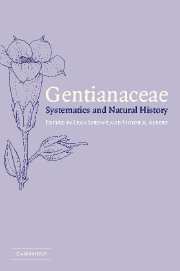Book contents
- Frontmatter
- Contents
- List of contributors
- Foreword
- 1 Gentianaceae in context
- 2 Systematics, character evolution, and biogeography of Gentianaceae, including a new tribal and subtribal classification
- 3 Cladistics of Gentianaceae: a morphological approach
- 4 Gentianaceae: a review of palynology
- 5 The seeds of Gentianaceae
- 6 Chemotaxonomy and pharmacology of Gentianaceae
- Index
3 - Cladistics of Gentianaceae: a morphological approach
Published online by Cambridge University Press: 08 August 2009
- Frontmatter
- Contents
- List of contributors
- Foreword
- 1 Gentianaceae in context
- 2 Systematics, character evolution, and biogeography of Gentianaceae, including a new tribal and subtribal classification
- 3 Cladistics of Gentianaceae: a morphological approach
- 4 Gentianaceae: a review of palynology
- 5 The seeds of Gentianaceae
- 6 Chemotaxonomy and pharmacology of Gentianaceae
- Index
Summary
ABSTRACT
The infrafamilial relationships of the Gentianaceae are investigated by means of a cladistic analysis of 84 phenotypic characters, based mainly on data from the literature. The 41 genera that were selected for the analysis, including the formerly loganiaceous genera Anthocleista and Fagraea and the monotypic genus Saccifolium, are a fair representation of the character diversity in the family. The diverse genus Gentiana is represented by six of its sections. As outgroups we used Strychnos and Geniostoma (Loganiaceae), Gelsemium (Gelsemiaceae), and two genera each of Apocynaceae and Rubiaceae.
In the strict consensus cladogram of all most-parsimonious trees Gentianaceae has an unresolved basal trichotomy between Saccifolium (of tribe Saccifolieae), Potaliinae, and a major clade including all other genera. In this clade only tribe Gentianeae and subtribe Chironiinae of tribe Chironieae (Ixanthus excepted) are recognized as monophyletic groups. Within tribe Gentianeae, subtribe Gentianinae is nested in a paraphyletic subtribe Swertiinae. The relationships between the representatives of Exaceae, Canscorinae and Coutoubeinae (Chironieae), and Helieae are almost completely unresolved. An interesting exception is the sister-group relationship between Exacum and Cotylanthera.
Two complementary explanations for the lack of resolution in most parts of the cladogram are discussed: (1) the morphological characters of most tropical members of the family are insufficiently known, and (2) morphological characters are not well suited to resolve the more basal relationships in Gentianaceae.
Keywords: Gentianaceae, infrafamilial classification, morphology, phylogeny, phytochemistry.
- Type
- Chapter
- Information
- GentianaceaeSystematics and Natural History, pp. 310 - 376Publisher: Cambridge University PressPrint publication year: 2002
- 1
- Cited by

